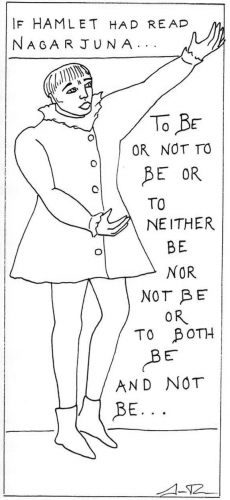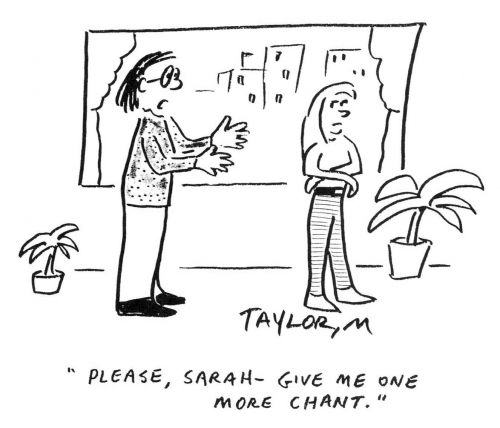Salute to the Son
I am writing to express my appreciation to Sakyong Mipham Rinpoche. I was especially taken by his support for Westerners’ taking more responsibility in the development of dharma and not depending so much on the Asian teachers. This is a refreshing view, as Tibetan teachers in particular so often express a proprietary or territorial sense of ownership about “their” dharma. I do not practice in a Tibetan lineage, but I have heard senior students complain that their Tibetan teachers deep down think that Westerners are barbarians who will just never get it right.
Trungpa Rinpoche’s books were an enormous help to me when I started out in dharma practice. His words were so encouraging. I never studied with him, but he actually convinced me that I had the capacity to attain the way. After reading his books, I could no longer tell myself that you had to be Asian, or Tibetan, or born Buddhist in order to get enlightened. It is wonderful to see his son continuing this generous encouragement.
Karen Dalwright
Spokane, Washington

Like the Fourteenth Dalai Lama, I am a Buddhist monk who likes movies. I am also a practitioner of the deityDorje Shugden, banned by His Holiness in 1996. I believe Hollywood’s mythification of Tibet is influencing Westerners’ views and attitudes toward this ban.
It is with great interest and concern as a dharma practitioner and teacher that I see the gap between reality and fantasy being perpetuated by Hollywood. It took me a while to realize that the Tibet I had been longing for in my youth did not exist outside of myself, echoed by the very last line in Frank Capra’s Lost Horizon (1937): “Here is my hope that we all find our Shangri-la.”
What we are getting with Seven Years in Tibet and Kundunis a perfectly pre-packaged image for Western consumption, presumably to advance the Tibetan cause. However, as William Ellison correctly pointed out in your Winter 1997 issue, “pragmatic exiles and scholars tell us that the Real Tibet is gone, that it’s too late for Hollywood to save Tibet, that the Chinese devastation is irreversible.” In fact, the “Tibetan cause” as presented to us is much like the Titanic, doomed from the beginning, as expressed by Heinrich Harrer in his book Seven Years in Tibet (1953): “Alas! As I knew, it was too late. He had come to the throne at the very moment when fate had decided against him. Had he been a few years older, his leadership might have altered the history of his country.”
Audiences are enjoying Titanic—I believe much more than they will Kundun. AlthoughTitanic contains a lot of fantasy and romance, it is much more honest, it shows us the suffering of the lower classes in the bowels of the ship, and we know it is going to sink. The movies about Tibet are not honest—they purposely create a make-believe reality. If we fall for it, we know we are going to be disappointed in the end, sooner or later. Such sufferings arise from attachment and ignorance; the law of karma taught by Buddha is unforgiving and relentless.
But now there is something of even greater concern happening as dharma practitioners are blinded by this image of His Holiness the Dalai Lama as god-king, the infallible savior, the last hope. This is a far cry from Buddha’s advice to use discriminating wisdom as our guiding light. As demonstrated by history, the consequences of such blind faith are disastrous, especially when placed upon someone who is a political leader.
At this time there is a very painful controversy arising from a strict religious ban on the practice of the deity of Dorje Shugden. This ban has been enforced by the Tibetan Government, making it a political issue. The worship of any deity should always remain strictly a religious issue, but, as we know, when church and state are mixed, political aims take precedent.
Dorje Shugden practitioners are now like the Sierra Leone people of the ship Amistad, arriving in America only to get caught up in a politically motivated trial with little hope for freedom. But this isn’t another Hollywood movie. This is our reality, and it demands from us our commitment to freedom rather than to fantasy. K. Togden
San Francisco, California

One Man’s Buddhism…
In reading Lawrence Shainberg’s interview with Robert Jay Lifton on Aum Shinrikyo (“From Mysticism to Murder“), I was disconcerted by Shainberg’s wonderment at how Buddhism could lead to the [violent tactics of the group]. I see the apocalyptic strategy of Aum Shinrikyo not as a “hairbreadthapart” from Buddhist doctrine, as Shainberg does, but rather as enmeshed with it.
Everything we think Buddhism is or want Buddhism to be is in Buddhism (as well as delightfully absent from Buddhism), and what Buddhism “means,” if anything, is what we come to believe it to be. We may find it a shame that Shoko Asahara wields such blinding control over others and has in his power ways of killing great numbers of people. But his Buddhism is just like my Buddhism, just like the Buddhism of each person in my sangha. I heard a talk radio host, sitting in for Rush Limbaugh, comment on the situation of the nuns from the Hsi Lai Buddhist Temple who had shredded crucial documents. He asked if “this Buddhism” had something to do with shredders and fax machines and modems. He wanted an all-binding explanation of “this Buddhism.” Unfortunately for him, and fortunately for me, there is nothing that suffices to explain every person who sits, who breathes, who bows…or who releases nerve gas into crowded subways.
Richard K. Weems
Lindenwold, New Jersey
Been There, Done That
It seems to me that Tricycle serves only those who grew up in the sixties counter-culture. I think the same can be said of many dharma and Zen centers, too. Please remember that there are those of us who were born in the sixties and who come to Buddhist practice from a different perspective: that of single-parent families, awareness of AIDS, and environmental problems—not from the standpoint of free love and mind-expanding drugs. These perspectives should be addressed (or at least kept in mind) more often in articles on Buddhist practice.
Anonymous

Guilty Till Purified
In Geshe Michael Roach’s piece on purification practices, he denounces a Western sense of guilt by saying, “It’s considered counterproductive to feel upset or angry with yourself about making a karmic boo-boo.” Instead, Roach urges us to “regret intelligently,”and then to clean up the mess by purifying the karma. This comparison implies that Westerners are crippled by guilt. The pejorative and somewhat silly description of “guilt” within a religious teaching points more to the author’s anti-Christian prejudice than to any kind of valid investigation into the ways guilt works as a moral guide that steers us clear of making mistakes in the first place. In that sense, guilt might eclipse the need for “purifying our bad karma” in the first place.
George Strakis
Seedy Practice
I always enjoy Wendy Johnson’s column “On Gardening;’ but was particularly engaged by the last one in which she celebrates the process of going to seed—for plants, for gardens, for all of us. I guess what really struck me is that so much of the style of Japanese Zen seems antithetical to “going to seed.” Zen is so tidy and crisp and its aesthetic has always struck me as cold and muscular. My own preference is for something cozier, less formal, less domesticated, and a little more “seedy.” So when Johnson rejoices “in the victory of the feral tangle,” I could not help but hope that her exhortation to “go to seed” might be taken to heart in her own zendo.
Lila Smith
Kansas City, Missouri
Correction
The photo caption on page 47 of the Winter 1997 issue of Tricycle was in error. The Manzanar internment camp was located in California, not Montana